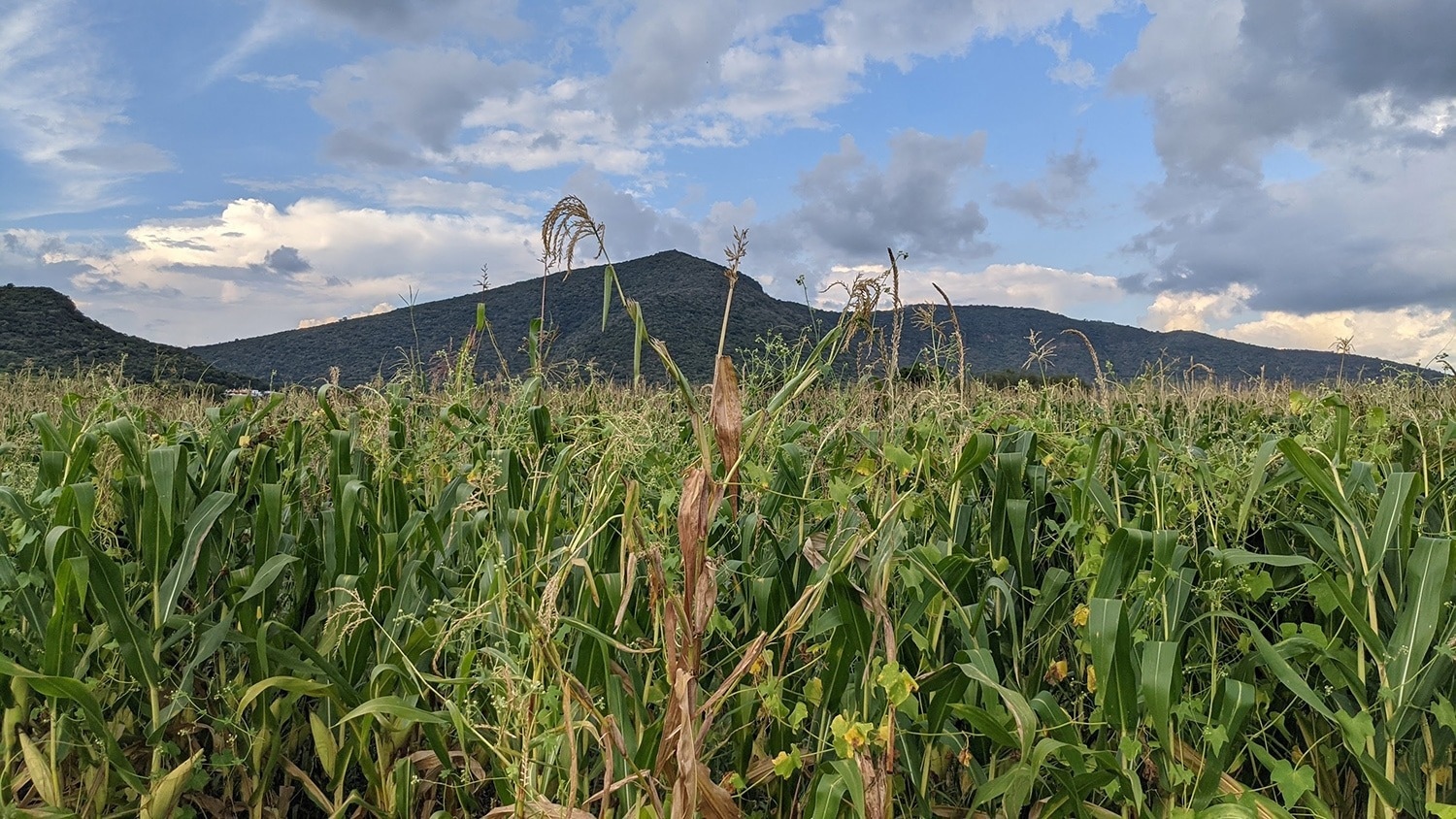North Carolina State University researchers revealed that a crucial gene in maize called HPC1 modulates some chemical processes that contribute to flowering time. It originated in “teosinte mexicana,” a precursor to modern-day corn that grows wild in the highlands of Mexico. The observations could have an impact on how corn and other crops adapt to low temperatures because they shed light on plant evolution and trait selection.
 A Teosinte mexicana plant grows on the border of a commercial cornfield. Image Credit: North Carolina State University.
A Teosinte mexicana plant grows on the border of a commercial cornfield. Image Credit: North Carolina State University.
We are broadly interested in understanding how natural variation of lipids are involved in the growth and development of plants, and how these compounds may help plants adapt to their immediate environments.”
Rubén Rellán-Álvarez, Study Corresponding Author and Assistant Professor, Structural and Molecular Biochemistry, North Carolina State University
Rubén Rellán-Álvarez adds, “Specifically, we wanted to learn more about variation in lipids called phospholipids, which consist of phosphorus and fatty acids, and their role in adaptation to cold, low phosphorus, and the regulation of important processes for plant fitness and yield like flowering time.”
Higher altitude maize cultivation, such as that found in Mexico’s highlands, requires particular conditions for successful crop production. When compared to maize cultivated at lower elevations and in warmer climates, these mountainous regions’ colder temperatures give maize a slight disadvantage.
“At high elevations, in colder temperatures, it takes longer to make a maize plant due to lower heat unit accumulation—corn needs to accumulate heat or growth units,” Rellán-Álvarez stated.
At 10,000 feet (2,600 meters), it takes three times longer to make a maize plant than at lower elevations. To adapt to these special conditions campesinos—smallholder farmers—must plant early in the season and plant deep in the soil; there is very slow but steady growth in earlier months until the rainy season arrives.”
Rubén Rellán-Álvarez, Study Corresponding Author and Assistant Professor, Structural and Molecular Biochemistry, North Carolina State University
Rellán-Álvarez added, “Over millennia, campesinos have selected maize varieties that can thrive in these special conditions by being able to grow at low temperatures and flower early before the colder months arrive in the winter.”
The HPC1 gene, according to researchers, plays a role in this. The gene destroys phospholipids in low-elevation corn varieties, including the majority of the corn produced in the United States, which have been shown in other species to bind to critical proteins that hasten flowering time.
Phospholipids are also important building blocks of cell membranes. All lipids have different shapes and balancing these shapes is what allows membranes to stay intact and helps plants to survive periods of stress.”
Allison Barnes, Study Co-First Author and Postdoctoral Researcher, North Carolina State University
Allison Barnes is a postdoctoral researcher in Rellán-Álvarez’s laboratory.
However, in the mountains, the gene misfires, but to the benefit of highland maize.
Rellán-Álvarez says, “In highland maize a defective version of the gene was selected and this led to high levels of phospholipids. We developed a CRISPR-Cas9 mutant and confirmed the metabolic function of the gene. We also showed similar phospholipid-protein interactions that had been described in other species to regulate flowering time.”
Barnes added, “The phospholipids that are not broken down in the highlands may be better for keeping membranes together, allowing the plant to survive the adverse environment.”
The highland version of the gene was observable in the extensive experiments that were conducted throughout Mexico’s lowlands and highlands and are detailed in the paper by the investigators.
They discovered that plants of corn that carried the highlands version of the gene flowered one day earlier than those that did not. Conversely, corn grown in the lowlands that carried the highlands version of the gene flowered a day later than plants that did not carry that version of the gene.
“It’s helping the plant do better in its local environment. If flowering doesn’t work, there will be no seed, so it’s not surprising that something involved in flowering time is also involved in local adaptation,” remarks Fausto Rodríguez-Zapata, a PhD student in Rellán-Álvarez’s lab and co-first author of the paper.
The study also looked at how maize evolved over many centuries of farmer selection in the Western Hemisphere. Native Americans domesticated corn from a wild plant called teosinte parviglumis thousands of years ago in southwest Mexico.
With great ingenuity, they transported and adapted corn across the Americas, from the deserts of Arizona and Perú to the humid forests of Yucatán and Colombia, including up to the Mexican highlands, where corn was crossed with another wild teosinte plant called teosinte mexicana.
“Our results show that the mixture of maize with teosinte mexicana helped maize adapt to highland conditions and that this mixture is relevant in modern corn,” stated Rellán-Álvarez.
The study’s authors demonstrated that the highlands variant of the HPC1 gene, one of the genetic components from Teosinte mexicana, has been preserved in contemporary maize.
“This retention—what scientists call introgression—is similar to modern-day humans retaining bits of Neanderthal in their genetic code. These pieces have been retained because they have been selected over time and bring some advantage,” Rodríguez-Zapata elucidates.
In line with the colder climate in those regions, the researchers also found the highlands variant of HPC1 in corn grown in Canada, the northern United States, and northern Europe.
To discover more environmentally friendly ways to grow maize and possibly incorporate more teosinte mexicana into contemporary corn, NC State researchers are currently examining the function of this gene as well as other genes involved in phosphorus metabolism.
Source:
Journal reference:
Barnes, A. C., et al. (2022) An adaptive teosinte mexicana introgression modulates phosphatidylcholine levels and is associated with maize flowering time. Proceedings of the National Academy of Sciences. doi.org/10.1073/pnas.2100036119.